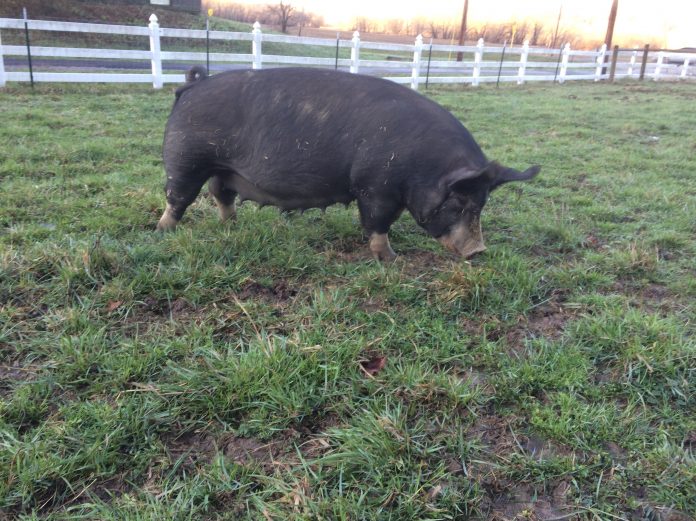We had our first warm day last week and thoughts of planting spring forages started dancing in my head.
Now, in the past, I have talked about mixed species grazing and I always include my pigs in the discussion.
This was a mainstay for farms in years past and has increased in popularity over the last few years.
I am not sure how many people are raising pigs on pasture, but for this small and growing group, this article is for you.
I’ll be the first to admit that pigs are not cows. It takes planning and good management to make the best use of pastures.
The best pig
Not every pig will get all of its nutrition on pasture.
Young, growing pigs need lots of protein. They can be raised on pasture, but they will need to get a large portion of their diets from a complete ration.
Where pastures really shine are with the mature breeding swine.
Sows should only need 2-3 pounds of a complete ration each day in order to maintain their weight and during gestation on good pasture.
What makes a good pasture for a pig?
Pigs do best on pastures that are high in protein. This means having a good mixture of grass and legumes.
Past research has been done mostly on grazing alfalfa.
If you have the right field and conditions, this might be your best option.
The biggest drawback for me is that pigs can be a little rough on a field and can really shorten the life of an alfalfa stand.
The key is to rotate them onto other fields to allow for recovery and when conditions are wet.
Since I have a smaller operation and am not ready to go all in on renovating my field by planting alfalfa, I want to take a look at some other options.
Which forage?
There are many options when deciding which forages to use with your pigs, starting with the clovers.
These can be added to existing grass pastures.
Alsike clover does well in acidic soils and on fields that tend to be a little wet. However, it doesn’t stand up well to hot, dry summers.
Ladino clover is a stand out for its high protein content and ability to keep producing through the summer.
Another good option for my fields that tend to be a little wetter is birdsfoot trefoil.
It has similar protein to alfalfa and holds up a little better under the conditions of my farm.
To round off the clovers, you can add red or crimson.
Both are fairly easy to establish and provide good nutrition. They just don’t stand out like the clovers mentioned earlier.
Korean or annual lespedeza is a related species that I can get started in an alternate field and allow it to grow until it is ready for summer grazing.
I know that the pigs don’t like it as well as the clovers, but it does fill a need in my pastures for a summer forage.
If you are like me, you will want to step up your game and move away from fescue.
Smooth bromegrass is a good addition to the pig pasture and goes well with the legumes.
It stands up to the grazing pressure of pigs and actively grows for a longer time during the grazing season.
Orchardgrass is another good grass for pigs. It stands up to being walked on and fairly palatable during its early stages of growth. The drawback is that pigs don’t like it once it starts to mature.
As for bluegrass, it’s good in the spring but tends to let you down during the summer.
Sorghum/sudangrass can fill in during the summer months if you understand how to manage it in preventing prussic acid poisoning.
One grass that I would not recommend would be Timothy as it doesn’t fit well in trying to graze pigs.
Other forages that do well in a swine pasture are rape and winter rye.
Pigs like rape and it provides a good forage during the growing season if it is not overgrazed.
It should not be grazed wet as it can lead to sunburn problems for light colored pigs.
Winter rye provides for a good forage during winter, if allowed to establish itself during late fall.
Rotating
As I mentioned earlier, pastures for pigs need to be well managed. Pigs are a little rough on the fields.
Plan on putting no more than 5 sows per acre or 6-10 younger pigs.
Plan on rotational grazing in order to give fields a rest and to plow, disk and reseed them every other year.
This will help to level the fields and break the disease and parasite cycles.
Economic
My final advice would be for you to do the math. Figure out the cost of establishing and maintaining a swine pasture.
Does it make economic sense for your operation or would you be better off just feeding a complete ration?
If you get stumped at this step, Ohio State University Extension has budgets available for establishing a pasture.
Get some help and don’t be afraid to put your pork out to pasture.













